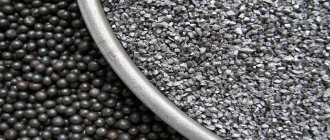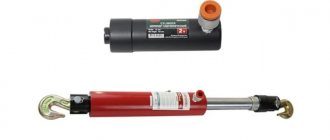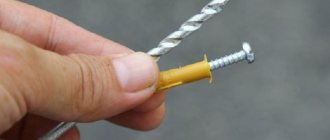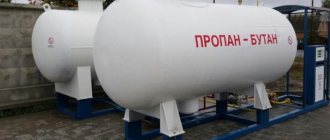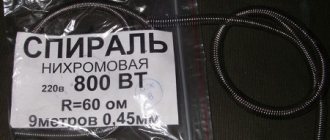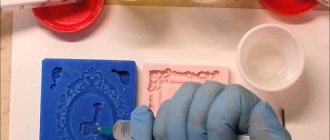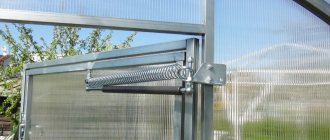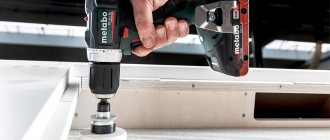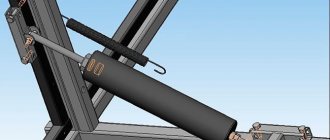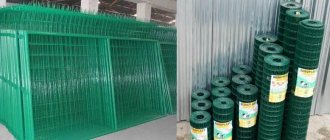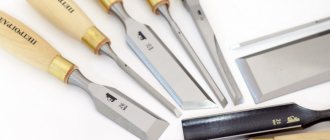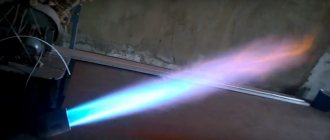Hydraulic cylinders are widely used in mechanisms that ensure the operation of construction equipment, road work machines, and agricultural machines. A hydraulic cylinder is an essential element of the design of a modern crane and excavator, combine harvester and hydraulic hammer - in short, all structures whose operation involves raising and lowering attachments.
- Hydraulic cylinder device
- Single acting types
- Double acting
- Telescopic
- Differential
The main principle of operation of a hydraulic cylinder is the conversion of hydraulic energy into mechanical energy. It passes through rotary-rectilinear or reciprocating movements. The working medium (liquid) for the hydraulic cylinder is water, mineral oils or a water-oil emulsion.
Hydraulic cylinder device
Externally, the hydraulic cylinder resembles a sleeve: it is a pipe with a smooth inner surface. This pipe is filled with liquid, which is pumped out and injected using a cylindrical rod (rod).
The working fluid enters under pressure, which activates the piston. In addition to the piston and the liner itself, the structure includes the following elements:
- Sealing elements. To prevent liquid from leaking, the design also includes rubber cuffs and protective plugs on the sides, which have holes for transporting liquid.
- Stock. It has the smoothest surface possible and transmits force from the piston;
- Grundbuks (axle box). Used as a rod guide;
- Wiper. It is used as an additional element of the sealing system, and also serves to protect the cuffs from solid particles and excess moisture getting into them.
- Eye. Connects the rod to the moving mechanism.
Hydraulic cylinders operate at elevated pressure, which can reach 32 MPa. Therefore, the requirements for the entire system are very serious: all parts must match each other as closely as possible and be as durable as possible. High functionality of the system is possible only if there are reliable parts and a carefully designed mechanism.
Eye of the hydraulic cylinder rod of the bucket eversion Amkodor 333, 342
Hydraulic cylinder for extending the traction frame of the motor grader DZ-143 photo2
Types
There are several classification methods, depending on the design features. Thus, according to the number of positions of the rod, models are distinguished, during which two positions or many positions are possible, and according to the type of stroke - single-stage and telescopic. Also, the hydraulic cylinder may or may not have a braking function. According to the type of fixation in the system, hydraulic cylinders are distinguished on hinges and on rigid fasteners.
One of the classifications takes into account the type of working link in the structure. The most common ones include:
- Piston. The rod for them can be one-sided or two-sided;
- Plunger The working element is a plunger (monolithic displacer);
- Bellows. The working element is a bellows. Designed for work at low pressure - up to 3 MPa;
- Membrane. They work with the smallest pressure - less than 1 MPa. The membrane is an elastic ring located in the body.
The most common classification is based on the type of direction of action of the liquid. According to this classification, hydraulic cylinders are single-acting, double-acting, telescopic and differential. Let's talk in more detail about each of these mechanisms.
Single acting hydraulic cylinders
The hydraulic cylinder for turning the loader bucket Amkodor 350, 352
The rod in such a hydraulic cylinder moves in one direction, returning to the original direction using a spring mechanism. Single-acting devices also include jacks that do not have a spring mechanism. In this case, the return of the rod is carried out due to the gravity of the load, which is lowered or raised, or with the help of another electric motor.
Double-acting hydraulic cylinders
Such devices use both forward and reverse stroke. The force on the rod is created due to the fact that increased fluid pressure is created in the cavities of the rod or piston cylinder. With the forward stroke, a greater gain at the start and a relatively low speed of movement are noted in comparison with the reverse stroke. The reason for this is the difference in the areas to which the fluid pressure force is applied.
Telescopic hydraulic cylinders
An extendable hydraulic cylinder that resembles a telescope (hence this device gets its name). It actually consists of several cylinders of different diameters inserted into each other. Telescopic hydraulic cylinders are also divided into single-acting and double-acting models. They are used in situations where the size of the device is limited, but a large cylinder stroke is required. A common design element of a dump truck.
Differential hydraulic cylinders
In hydraulic cylinders of this type, pressure on the piston is applied from both sides at once, and with different areas of pressure on different sides. The speed of movement under such conditions is proportional to the ratio of the areas of the piston - accordingly, it is inversely proportional to the final force. The lower the speed, the higher the force exerted, and vice versa.
If the piston sizes are in a 2:1 ratio, the hydraulic motor provides identical speed in both directions. Cylinders with a one-way piston do not have such properties - unless they are equipped with special adjustment devices.
Design features and principle of operation
The design of any hydraulic cylinder includes the following elements:
Plunger hydraulic cylinders are somewhat different in design, in which the plunger simultaneously performs the functions of a piston and a rod.
Hydraulic cylinder diagram
The operating principle of any type of hydraulic cylinder is based on the pressure of the working fluid on the piston. As a result of the impact on the hydraulic cylinder piston, the rod begins to perform cyclic work, transmitting force to the working unit of the equipment served by the device. Such a working unit, the functioning of which is ensured by a hydraulic cylinder, depending on the type and purpose of the equipment, can be a compacting platform, a bending or pressing mechanism, as well as a device of any other type that ensures the transmission of the force of the hydraulic cylinder to the final recipient of power energy.
Sliding hydraulic cylinder device
Since the force created by a hydraulic cylinder, as mentioned above, is formed due to the pressure exerted by the working fluid on the piston, the properties of this fluid have a significant impact on the efficiency of use, technical and operational characteristics of the cylinder itself. As a working fluid for piston or plunger type hydraulic cylinders, as a rule, a special oil is used, which must meet certain requirements for a number of parameters:
- chemical composition and density;
- temperature values at which the working fluid retains its original characteristics;
- the tendency of the working fluid to develop oxidative processes.
To operate hydraulic cylinders of various types and models, working fluid is pumped into their internal chamber using a manual or electric pump.
Specifications
The effectiveness of their use in a particular area and the service life during which the units can be used effectively depend on the parameters and characteristics of hydraulic cylinders. In order to quickly select a replacement part in case of repair, you need to understand the structure of the hydraulic cylinder and have an idea of its main operating parameters. These are the parameters:
- Rod diameter. The scope of use depends on it: products of different diameters are installed in different mechanisms. The specific diameter of the rod is selected when calculating the load on the mechanisms and the load-carrying capacity of the device. If these calculations are carried out correctly, then the rod will not deform during operation. The rod diameter is no more than 500 mm;
- The diameter of a cylindrical rod - a device with which the pushing and pulling force is determined;
- Characteristics of the stroke of a cylindrical rod. The dimensions of the mechanism in working condition and the characteristics of the piston movement depend on them. Maximum stroke value – 10,000 mm;
- Design features that determine the methods of fastening the hydraulic cylinder and calculating the load on the fastener;
- Pulling and pushing force on the rod (in kilograms);
- Nominal pressure (in megapascals);
- Distance on centers (in non-operating condition). Thanks to this, it is possible to effectively calculate the connecting dimensions;
- Weight, length and width of the product itself.
- Ambient temperature during hydraulic cylinder operation. The minimum is minus 40 degrees Celsius, the maximum is +40.
Recommendations for use
The efficiency and correct functioning of hydraulic cylinders, which are the main elements of hydraulic systems, depend on the quality and technical condition of the latter. That is why the issues of operation and maintenance of hydraulic cylinders should also be approached systematically, assessing all factors that may influence the efficiency of their use. Thus, it is necessary to check pumps, oil lines, valve devices and filters.
When using presses equipped with hydraulic cylinders capable of developing forces that can amount to tens of tons, one must remember not only the rules for operating such equipment, but also compliance with safety measures.
Where are they used?
Hydraulic cylinder for turning the bucket of the 702EM backhoe loader
In devices that have hydraulic motors in their design, operate under heavy loads and require increased functionality. These are, for example, construction and repair, road and earth-moving equipment, cleaning units. Modern cranes and dump trucks, bulldozers and heavy-duty vehicles cannot be imagined without hydraulic cylinders. In addition, they are used in production: they are equipped with machines that cut metal, forging units, and presses.
GOST hydraulic cylinders
All technical characteristics and parameters of the cylinders are determined by GOST 6540-68, GOST 16514-96. The relevant GOST annexes contain information about the values of piston and rod type hydraulic cylinders and their correspondence to each other. Also, the provisions of this standard mention a hydraulic cylinder and a pneumatic cylinder of piston and plunger type.
Another important value specified in GOST is standard pressure. This is a constant value that should be taken into account when calculating operating capabilities.
The standards also indicate the designations of hydraulic cylinders, which differ depending on the design features. However, it is worth remembering that different cylinder manufacturers may use different designations.
When buying hydraulic cylinders, you need to take into account specific parameters and criteria, calculate the required values, otherwise the device will not perform its job fully and uninterruptedly. The main parameters include:
- sleeve dimensions (outer and inner diameter);
- rod diameter;
- stroke of the piston (plunger);
- length of the cylinder along the mounting axes (installation size);
- geometry of forks and lugs;
- the material from which the hydraulic cylinder elements are made;
- the mass of the cylinder as a whole and its individual parts.
Taking into account all the listed features will facilitate the operation of the cylinder and, in the event of a breakdown, will allow you to quickly solve the problem by replacing the cylinder or a separate part.
Main varieties
Different types of hydraulic cylinders are distinguished according to a number of parameters. So, depending on the number of positions that the device’s rod can occupy, it can be:
Depending on the nature of the stroke of the piston and rod, the following types of hydraulic cylinders are distinguished:
- single-stage devices;
- telescopic hydraulic cylinders.
Operating principle of various types of hydraulic cylinders
A single-acting telescopic device or a double-acting telescopic hydraulic cylinder is used in cases where it is necessary for the rod overhang to exceed the length of the hydraulic cylinder body. A telescopic hydraulic cylinder consists of several cylinders that are nested one inside the other, and the body of each subsequent cylinder is the rod of the previous one.
